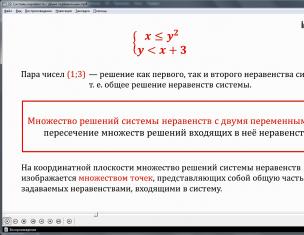M.: KMK, 2000. - 449 p. — ISBN 5-87317-079-7 The book illustrates the use of the undeservedly forgotten comparative method in global and private historical research. The complex interaction of historical processes of a worldwide nature, such as Westernization, with the characteristics of individual societies, determines the specific morphology of history - those forms of development of societies that we observe. As a result of the morphological study of history, it is discovered that psychological characteristics people change from era to era. The consequence of these mental changes are many social, political, economic processes, and it is with them that the periodization of human history is connected. In connection with the natural change in the characters of people and civilizations participating in the historical process, the structure of society also changes at each historical stage. The book examines the interaction of parts modern society; culture, state, economy. The morphological approach to history allows us to explore failed versions of history, to characterize those historical opportunities and forks that took place in the past and await us in the future. The book is addressed to historians, philosophers, sociologists, cultural scientists, political scientists and a wide range of readers. Methodology of historical research: comparative method.
Comparative method in historical research. Own time. Morphology of society.
Harmony of the spheres. Triune formula of social structure. State. Economy. Culture. Free cultural life: continuity and education. University. Ecology of culture. Diversity of culture. Homological series of historical phenomena.
Borrowings. Fashion. Steresis. Waves of Westernization. Chimeras. Modernization. Feudalism and the formation of nation states.
Three spheres in feudalism. The development of feudalism: fugue and variations. Features of European feudalism. Origin of chivalry. Romano-Germanic synthesis. Comparison of European chivalry with its eastern counterpart. German folk character and feudalism. Folk characters and their characteristics. Features of European development in other areas of culture. Scholasticism and the development of the “spirit of Protestantism.” Changing the concept of nationality. Formation of nation states. Control of violence. Merger in the 15th century. statehood and nationality. Decomposition of nationality into components. The wave of formation of nation states. State scheme. Ring of time. Changing the human soul as a reason historical changes.
A number of homologies in culture. Variations of the Renaissance. Eastern Renaissance. Individualization of personality. A new attitude towards nature, death, body, gender. The birth of a landscape. Inner life. Floor. Trips. Mysticism. Metaphor of court. The birth of modern philosophy. Sequence of styles in art. Place of "Russian revival". Reformation. "Pre-Reformation". Cluny reform. "Russian Reformation" and Schism. Individualization of religious life. National feeling. Borders of eras.
Changes in the human soul at the borders historical eras. Stages of soul development. Family tree crops Crisis of polis consciousness: The Peloponnesian War. The crisis of Chinese consciousness under Confucius. Sophists. Crisis of polis consciousness: Rome. Religions of directed time. Changing ideas about time. The phenomenon of non-authorship. Natural and artificial culture. Education: non-university. Sport. Science. Asian science. Characteristics of second thinking. Serfdom and the absolute state.
Payment for freedom. The Magna Carta and the extension of privileges. Abolition of serfdom. Serfdom in Russia. The era of revolutions. Japanese miracle. Japanese national character. Absolutism: Empires of the New Age. Bureaucracy: features of the new society. Reasons for absolutism. The formation of empires. Human history as special case development.
Laws of development and a three-part social whole. German shift and Russian heterochrony. Polarity: West and East. Gradient. Development as a whole. Democratic society. Prognostic ideas arising from the morphology of history.
Biological crises and social analogies
The theory of evolution - a “birthmark” of the 19th century?
From people I know with a humanities education, I often hear: “Evolution? Darwinism? Is this theory still being taken seriously here in biology? Hasn't she been rejected yet? This is something so outdated..."
Why does a scientific theory evoke such an attitude? Perhaps this is the result of forced adherence to Darwinism in Soviet era: in order to undermine trust in something, you need to make this “something” publicly available, or even better, mandatory. Only the secret seems important. In fact, the “Darwinian” theory of evolution is one of the most significant achievements natural sciences and one of the greatest (and still not fully appreciated) achievements of human culture.
Twenty or thirty years ago it was fashionable to say that there were “one-story” and “multi-story” sciences. Multi-storey is, of course, “Her Majesty” physics. From the basic concepts that lie at its foundation, entire bodies of more specific theories have grown, with their own complex methods and intricate corridors of consequences and principles. And biology is a one-story science, all there is is a sea of facts and one floor of theory - Darwinism.
But today the biological theory has grown incredibly. The dull barracks of the same type of explanation were replaced by a whimsical abundance of turrets, covered passages, and courtyards closed from prying eyes. And among them rise multi-story buildings molecular biology and population genetics, there are half-forgotten labyrinths of morphology and taxonomy theory... As in physics, today's ecologists do not understand phylogeneticists, and those do not understand embryologists... So we have grown up!
In this “modern building” the theory of evolution is no longer Darwinism - it, in its classical form, really belongs to the 19th century. By now, the very appearance of this theory has changed - it is simply impossible to talk about all its “superstructures” and “alterations”. Let's try to arrange a tour of just one of the youngest extensions to the building of biological theory.
Competition, progress and dead ends of specialization
The classical “Darwinian” theory of evolution necessarily includes the thesis of “survival of the fittest”... In the 19th century. this thesis was literally “in the air,” and it is not surprising that it moved from the sociology of Malthus to biological theory, and then vice versa - the mechanism of interaction between species developed by Darwin began to be considered in relation to social life. Even such a funny trend has appeared - social Darwinism. They seriously believed that in the “struggle of life” the one who is more fit will win: a good specialist will win in the competition of a bad one, goods high quality– goods are unreliable (and cheap), the society of “white collars” will always win over the society of “unwashed necks”. Good old nineteenth century...
However, later, from such a situation, they deduced the inevitability of progress and growth in the well-being of the masses, up to inconceivable in simple language limits. Both the Bright Communist Future and the Great American Dream were unanimous in this.
The difficulty, both in Darwinian theory itself and in attempts to apply its provisions to social life, was caused by the existence of such a concept as the “dead end of specialization.” Its meaning is very simple. If you want to climb higher, then moving exclusively up is not the best strategy. Because when you reach the top, it may be the top of the nearest hummock or hillock. Where you will stay, looking at the mountain peaks towering around you. After all, to get to them, you must first go down. Sometimes to the bottom of a deep abyss.
Likewise, the desire for perfection in one direction - specialization - “drives” the species into a certain state most adapted for this direction. True, even in this state you can live comfortably for quite a long time - until conditions radically change environment. Nevertheless, the history of the development of life on Earth shows us examples of constant improvement. Reaching the “nearest peak” does not stop progress - someone moves on and reaches new heights.
Another important point is the presence of facts that do not really confirm the theory of survival of the fittest, examples of a decrease in the number of specialized forms while simultaneously increasing the number of unspecialized forms.
Thus, in the Oligocene (a geological era distant from our time by approximately 20–35 million years) in North America the number of didelphid marsupial mammals (relatives of the modern opossum) - very weak specialists - increased. And the number of good specialists, for example, creodonts (extinct large predators), decreased. And only after this do they begin to occupy a dominant position in the North American fauna modern bands: predators - dogs and cats, insectivores - hedgehogs, moles and shrews.
In South America, non-specialist didelphids dominated back in the Cretaceous period - about 80 million years ago, and then, “as expected,” they began to be replaced by more specialized groups: predatory and insectivorous marsupials of other groups, as well as terrestrial crocodiles and large flightless birds of prey. . By the Miocene (about 15 million years ago), a community of perfectly adapted forms had formed here, remarkable specialists in their fields, closely connected by biocenotic connections with each other. But then, in the Miocene, the number of these species began to decline against the background of an increase in the number of the same weakly specialized didelphids.
True, throughout the history of the Earth South America it was either connected to the Northern Isthmus of Panama, or found itself cut off when the isthmus was flooded by the sea. So some changes in the fauna of this continent can be explained by the periodic influx of migrants from the north. But the Miocene increase in the number of didelphids began long before the next invasion from the north. “Professionals” disappeared without any apparent reason, and in their place all sorts of vains and shantraps multiplied, lovers of easy money, who really didn’t know how to do anything.
From the point of view of the usual theory of evolution, this is simply nonsense: a strong specialist, protected from head to toe from all blows of the environment, is defeated by someone completely incompetent. David and Goliath. Is there any way to explain this?
What happened in the Mesozoic?
True, in the history of life on Earth there have been quite a few crises, accompanied by the extinction of various groups of animals and plants. Of these, the most famous is a not very significant event - the extinction of the dinosaurs. In fact, it was not the case that dinosaurs, and only dinosaurs, became extinct overnight. But it was different: at the end of the Mesozoic (about 60 million years ago), several groups of reptiles became extinct, of which the most characteristic were dinosaurs. Declines in the number of dinosaurs have happened before, but then some of their groups were replaced by others. At the end of the Mesozoic, dinosaurs were finally replaced in communities by other groups of animals.
Why do people like to talk and write about this event so much? Because this is a bright topic - dinosaurs were so big, and suddenly they became extinct. “Big” is from a thriller, “suddenly” is from a detective story, and that’s why it’s interesting. However, in this formulation, the problem of dinosaur extinction is more literary than biological.
Meanwhile, several tens of millions of years before this extinction - in the first half Jurassic period– life on Earth went through a much deeper crisis. Then there was a unique in its scale reduction in the diversity of terrestrial tetrapods (tetrapods): amphibians, dinosaurs and other reptiles - pterosaurs, crocodiles, lizards, as well as the ancestors of mammals.
At the same time, there were no global climate changes in the Jurassic that could lead to such environmental crisis. It seems that there were no cosmic catastrophes: such catastrophes should have affected all groups of animals and plants, but this was not noticed.
Survival strategy and community breakdown
Analyzing the Jurassic extinction of the terrestrial tetrapod community, Russian paleontologists V.V. Zherikhin and A.S. Rautian nominated new theory ecological evolution.
As is known, in nature, most organisms are united into communities, or biocenoses. It is these communities that ensure the sustainable existence of life on Earth. Organisms are constantly exposed to solar radiation, various chemicals, temperature - in short, factors leading to mutations that change the hereditary material. And with a change in structure, the requirements of organisms for the environment and for the community conditions surrounding them also change. But the community itself, the structure of the connections that have developed within it, regulates such deviations, returning the changes to the norm. After all, there is no place for evolutionary innovations in a good stable community; all ecological niches here are already occupied.
It turns out that, while providing its members with a sustainable existence, the community simultaneously inhibits phylogeny, i.e. the emergence of new taxa - species and other systematic groups. Moreover, over time, the rigid structure of the community becomes more and more rigid, and the specialist species that make it up become more and more specialized.
But then the unexpected comes - a crisis. Its cause may be external, “obvious,” consisting of a sharp change in environmental conditions, such as global climate change or the fall of an asteroid. But it can also be internal, a consequence of certain types of inconsistencies that arose during specialization, which are especially dangerous in communities with a rigid structure. With a certain accumulation of such inconsistencies, the community disintegrates. And it disintegrates according to certain patterns, precisely in “places of inconsistencies” - regardless of what the nature of the external push was (comet, volcano, cold snap) and whether there was such a push at all. In any case, it breaks where it is thin.
To be continued
How is scientific taxonomy born from folk taxonomy? How they are born scientific concepts, are they arbitrarily invented, rationally constructed, or occur in some other way? How are terms created from ordinary words? How does science emerge, what is needed for a method to emerge? scientific knowledge? It is probably impossible to answer these questions completely yet, but it is already possible to give some pictures of how this happens, in the light of recent changes in our ideas about the history of science. A meaningful topic that illustrates these difficult issues is the development of botany, the scientific revolution associated with the names of Cesalpino and Linnaeus.
* * *
by liters company.
© Publishing house “Languages of Slavic Culture”, 2015
© Lyubarsky G. Yu., 2015
In the 17th century a unique event occurred in world history - the birth modern science. The significance of this civilizational invention is difficult to overestimate. We now do not eat bread or meat, we eat and drink science, and the 7 billion people of the Earth live by science. A very rough estimate of how many people the Earth can support in its natural state is the first hundred thousand people. This is approximately what the number of our species should be, if we try to proceed only from biology. At the end of the Paleolithic, about 15 thousand years ago, about 3 million people lived on Earth. At the end of the Neolithic, 2000 BC. e., there were about 50 million people. In the 17th century. There were approximately 600 million people on the planet. After that, a lot happened, including the “green revolution”, genetically modified plants, and modern medicine. In the 18th century The first demographic “leap” occurred, followed by several more.
In general, we can say that the current population of the planet could not be maintained without modern science, which created social institutions of medicine, food production, etc. The point is not that absolutely every person on the planet “eats science” - but if you stop the development of science and retreat, there will be a catastrophic drop in numbers, and it’s easy to imagine the consequences - these are, first of all, large-scale wars. So the social system will not remain “the same,” and in this sense, we all, humanity as a system, all feed on science. The system turned out to be very effective - now there are approximately 6 million scientists on the planet, the population is three orders of magnitude larger. Of course, in social system sciences include not only scientists, but ultimately it comes down to these 6 million people.
This means that we all, regardless of lifestyle and existing sympathies, live the fruits of a special social institution– science. It is clear that we are extremely interested in how this happened. Can we repeat this on occasion? Do we know the reasons? Did this really happen once? Are these reasons still valid? There can be a lot of questions.
Research on the history of science has shown that, although the level of handicraft production, population density, intensity of trade contacts and many other indicators more than once in the history of the Earth turned out to be comparable to what was achieved in Europe in the 17th century, science appeared only once. Once, but many times at once. It turned out that different fields of knowledge had their own scientific revolutions, unrelated to each other. Mechanics and optics had their own revolution, biology had its own, linguistics had another, and there were quite a few of them. Then they intertwined into something more or less unified, although the “scars”, or boundaries of division, remained visible - it is unlikely that the systems of knowledge that we call humanitarian, natural and mathematical sciences, homogeneous. Most likely, we have before us “three sciences”, three different types knowledge, on rather vague grounds, united into something unified. And maybe there are even more of them.
Science appeared several times in a row, and this allows us to compare different paths of emergence and note characteristic features and the body of ideas that in each case led to the establishment of science. But the most famous and long considered exemplary scientific revolution is the revolution in physics, mechanics and optics, associated with the names of Galileo, Kepler and Newton. Usually the conversation goes as if first there was a revolution in physics, and then other sciences began to branch off from it, so that the events of the 17th century. in physics should be considered as a permanent example of the emergence of science. From this point of view, such a particular area as the taxonomy of living organisms is located far on the periphery of science, far from fundamental physics, and therefore it was initially clear that everything in it was approximately the same, only weaker and less common, so what can be expected from There is nothing particularly interesting to study in this area.
However, the revolution in the field of biological taxonomy, even more broadly, the revolution of biological knowledge, occurred almost earlier than the revolution in physics. And within biology (there was no such science yet; the name appeared a century and a half later), there were also several revolutions; Harvey’s physiology, say, developed independently of the successes of botany. But the entire biological field developed independently of the advances of mechanics, so that the biological scientific revolution is an independent history of the emergence of science. This makes it possible to compare independent scientific traditions and evaluate the fruitfulness of certain ideas that find themselves in a different environment and applied to different material.
It is clear that the scientific tradition, the emergence of which we will consider - scientific taxonomy, the identification of living scientific objects, recognized as the subject of scientific knowledge - developed from some kind of non-scientific, pre-scientific state. And we will be interested, first of all, in the history of how it happened that from knowledge that we would not classify as science, something else developed. Now it seems that science is “simply” rational knowledge, or “simply” empirical, that you just had to pay attention to experience, discard superstitions, and everything will work out right away. In fact, the history of rationalism is at least a couple of thousand years older than science, and reliance on experience and empiricism is an eternal companion of human knowledge. Why and how were they able to unite into what is called science? Are reason and experience sufficient for the emergence of science?
To answer such questions, one should turn to very deep foundations of knowledge - after all, modern biology works with a ready-made object isolated in nature: living organisms. It is believed that biological objects - plants, animals - obviously exist. This is not questioned; methods of their structure, behavior, and changes are studied. But before there was neither the science of “biology”, nor the concept of “living being” in the modern scientific sense, there was no “plant” as a subject of scientific knowledge. All these concepts developed together - a new area of intellectual activity arose - science, a separate science about living beings arose, and at the same time the subject of this science appeared for the first time.
* * *
The given introductory fragment of the book The birth of science. Analytical morphology, classification system, scientific method(G. Yu. Lyubarsky, 2015) provided by our book partner -







